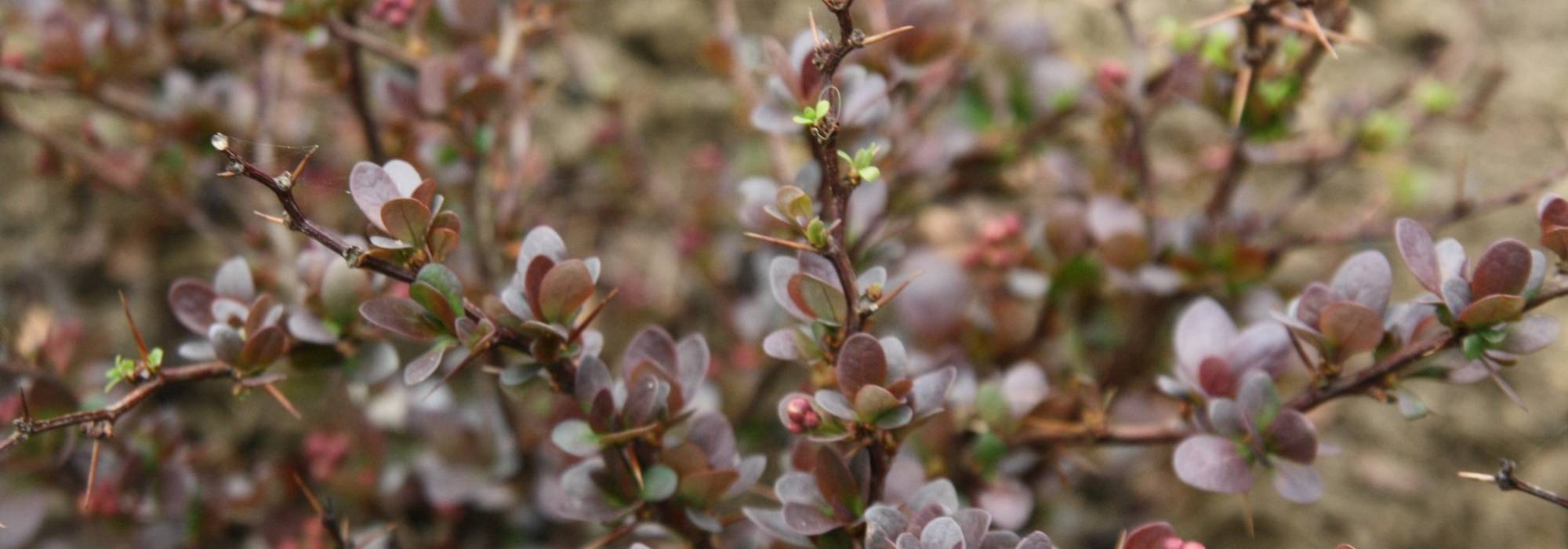
Berberis, thorny barberry: planting, pruning, and caring for
Contents
Berberis, in a nutshell
- Berberis are deciduous or evergreen bushes, varying in shape and size, and they respond well to pruning.
- Deciduous varieties often display richly coloured foliage, while evergreen varieties offer spectacular flowering followed by decorative fruits.
- Highly thorny, berberis can be used to create defensive hedges or to accompany a flower bed.
- Hardy, they thrive in any soil, in full sun or partial shade, and require no care: in short, an ideal plant for beginners!
A word from our expert
Berberis or Barberry are striking spiny bushes, with an upright or strongly spreading bushy habit, reminiscent of Mahonia in some aspects. These bushy shrubs, rich in 400 species, exhibit a wide variety of appearances but always have small to medium leaves, often with spiny edges. However, it is the fine thorns located in the axil of each leaf that form formidable tridents, highly sought after for creating defensive hedges.
Barberries can be classified into two groups:
- The group of deciduous species whose leaves are often ovate with smooth edges, in shades of purple, pink, tricolour, etc., such as Berberis x ottawensis and Berberis thunbergii Atropurpurea. Their autumn foliage often takes on magnificent scarlet colours, while the lemon-yellow flowering in May-June remains quite discreet.
- The group of evergreen species presents various leaf shapes, linear like Berberis linearifolia, spatulate like buxifolia, or small holly-like leaves such as darwinii or verruculosa. The flowering in dense bouquets of orange-yellow and fragrant blooms is often remarkable and early, as seen in darwinii, which flowers in March-April.

Some Barberries with decorative foliage: Berberis thunbergii ‘Admiration’, Berberis buxifolia ‘Nana’, Berberis thunbergii ‘Atropurpurea Nana’, Berberis thunbergii ‘Rosy Glow’, Berberis thunbergii ‘Thunderbolt’
All these shrubs are very easy to grow in any type of soil, preferably in full sun. They integrate perfectly into a low, medium to high hedge, whether free or trimmed. Compact rounded varieties like thunbergii ‘Bagatelle’ or darwinii ‘Nana’, dense upright forms like ‘Golden Torch’, or groundcover types like thunbergii Green Carpet make excellent rock garden subjects that can also be showcased as standalone plants or on a terrace or balcony. The thorns vary in length and sharpness depending on the cultivars, so it is wise to check their prickliness before placing Berberis in a high-traffic area. Avoid positioning it at eye level for children, in particular. Among the less spiny varieties, one can find Berberis x frikartii, buxifolia ‘Nana’, x hybrido-gagnepainii, thunbergii ‘Coronita’ (which has no thorns at all), and ‘Green Carpet’.
Description and Botany
Botanical data
- Latin name Berberis
- Family Berberidaceae
- Common name Barberry, Barberry bush
- Flowering between March and June
- Height between 0.30 and 3 m
- Exposure full sun or partial shade
- Soil type any soil, even poor, without lime depending on the variety
- Hardiness Excellent (-15 to -35°C)
Barberries are shrubs native to the Far East, the Andean regions of South America, and Europe, including some species like vulgaris. The genus comprises over 400 species, with North American species now classified under the genus Mahonia. They are also known as barberry, barberry bush, or vinegar bush, as the coral-red, juicy, and very sour fruits of Berberis vulgaris were once used to make a wine called vinettier. They were also pickled in vinegar like capers or consumed as jam or syrup. This species, found from France to central Russia and northeastern Turkey, has spread to North America, where it has become invasive. It is also feared by wheat growers who conduct uprooting campaigns as it harbours wheat rust, a fungus that requires Berberis to complete its life cycle.
Berberis vulgaris, forming a bush with arching branches reaching 3 m in height, is very common in plains and mid-mountain areas up to 2000 m altitude, particularly in rich, calcareous soil. The shrub can live for 30 to 50 years. However, this species is rarely planted for horticultural purposes, overshadowed by more compact, floriferous varieties with colourful foliage such as thunbergii ‘Atropurpurea’ or thunbergii ‘Harlequin’, which have young shoots that are reddish-orange turning pink (variegated purple with cream, to be precise) and also display beautiful autumn colours.
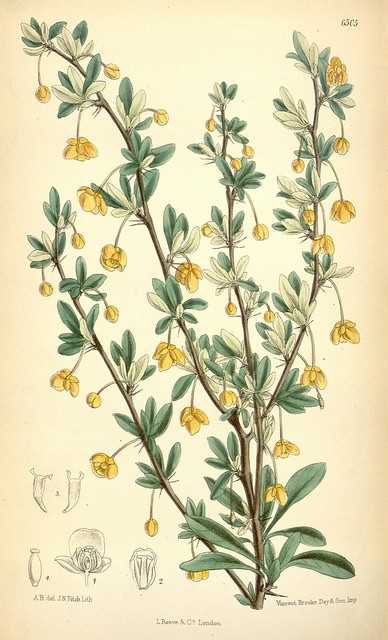
Berberis buxifolia – botanical illustration
The evergreen species of Berberis are slightly less hardy (-15°C) than the deciduous ones (-35°C). They form a dense bush between 1 and 3 m, often extended by a tangle of arching branches that makes a barberry hedge impenetrable. Birds find protection from predators within them. The alternate, leathery, glossy green leaves are dentate, sometimes even spiny at the edges like holly. The lamina size varies from 1 to 2 cm long in Berberis darwinii to 4 cm in linearifolia. The branches are also armed with thorns arranged in threes, resulting from the transformation of leaves.
The flowers of Berberis are often yellow or orange, sometimes cream or reddish, measuring 3 to 15 mm in diameter and grouped in clusters, solitary, or sometimes in umbels. The 6 yellow sepals, preceded by 3 prophyllum-shaped bracteoles, fall quickly after blooming. The 6 petals, equipped with nectariferous glands, remain along with 6 stamens and a pistil. The generally fragrant flowering is highly melliferous, attracting numerous pollinators in early spring.
The fruits are small round or elongated berries that are often very decorative in autumn, tinted pink, red, or blue-black, tangy, sometimes tasty, containing one or more pips. The berries of Berberis vulgaris are consumed dried in Iran under the name zereshk, but also as jam, jelly, or syrup.
The name Berberis was assigned by Carl von Linné, who believed the shrub originated from the region inhabited by the Berbers (Algeria).
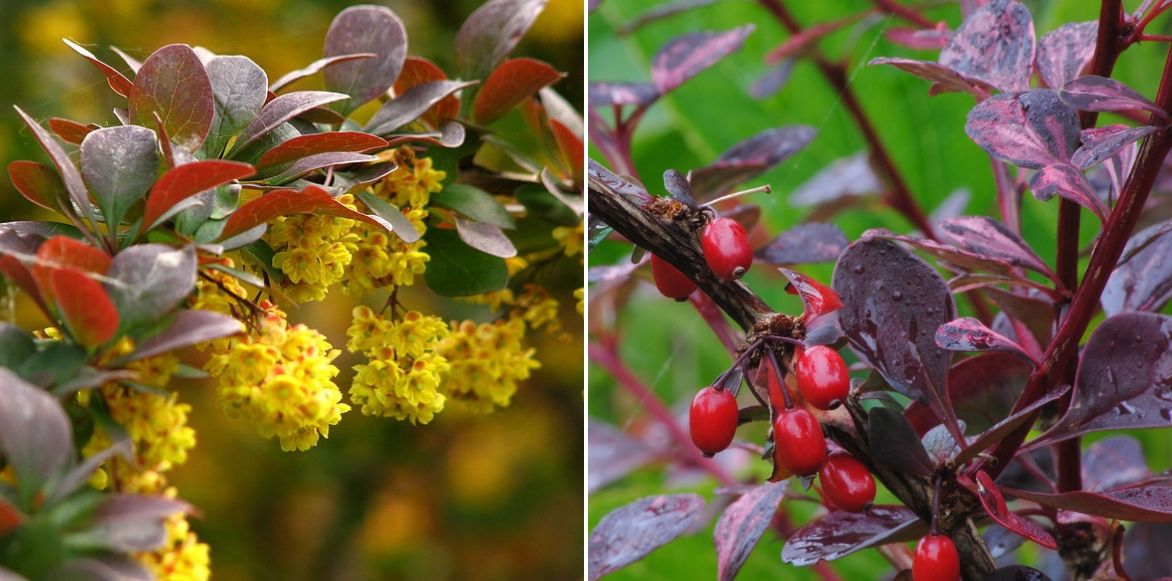
Berberis thunbergii: flowering and fruiting (photo Clint Budd-Flickr)
The main varieties of Berberis
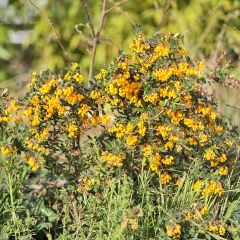
Berberis darwinii Compacta - Barberry
- Flowering time May, June
- Height at maturity 90 cm
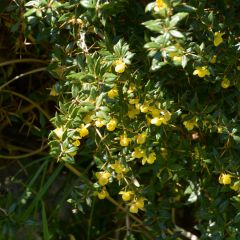
Berberis x frikartii Amstelveen - Barberry
- Flowering time May, June
- Height at maturity 1,30 m
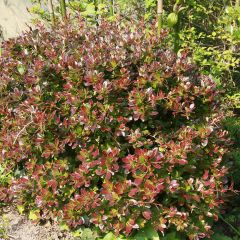
Berberis x media Red Jewel - Barberry
- Flowering time May, June
- Height at maturity 2 m

Berberis thunbergii Thunderbolt
- Flowering time May to July
- Height at maturity 90 cm
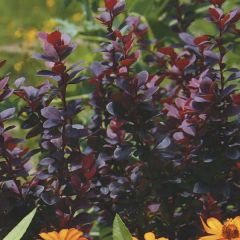
Berberis thunbergii Bagatelle - Barberry
- Flowering time February
- Height at maturity 40 cm
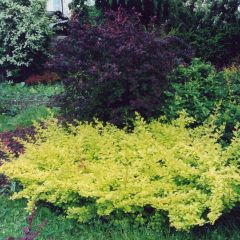
Berberis thunbergii Golden Carpet - Barberry
- Flowering time May, June
- Height at maturity 50 cm

Berberis thunbergii Admiration - Barberry
- Flowering time June
- Height at maturity 1,20 m
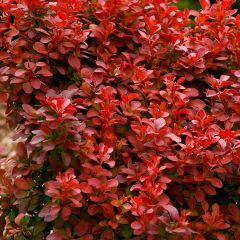
Berberis thunbergii Orange Rocket - Barberry
- Flowering time June
- Height at maturity 1,50 m
Discover other Berberis - Barberries
View all →Available in 2 sizes
Available in 1 sizes
Available in 2 sizes
Available in 1 sizes
Available in 1 sizes
Available in 1 sizes
Available in 3 sizes
Available in 1 sizes
Available in 1 sizes
Available in 3 sizes
Planting
Where to Plant Berberis?
Barberries are well-suited to pollution and appreciate, with few exceptions, all types of fresh to dry, well-drained soils, even poor and calcareous. The species Berberis darwinii prefers clayey, neutral to acidic, humus-bearing or light soils but tolerates drought very well once established.
A sunny position enhances the intense colouring of deciduous foliage as well as flowering, but Berberis are accommodating and can thrive in partial shade in the South and West of France. Species with evergreen foliage prefer partial shade rather than full sun and should be planted in a sheltered area from winds. They are slightly less cold-resistant than deciduous species, tolerating down to -15°C compared to -40°C for B. x ottawensis, but they do tolerate sea spray. Late frosts can sometimes affect young shoots, but the plant will produce new shoots without issue.
When to Plant?
It is preferable to plant Berberis in autumn to ensure deep rooting before facing summer drought. However, container-grown plants can be planted at any time except during frost or drought.
How to Plant?
Choose plants that are not too developed, around 30-40 cm, to ensure good establishment. Wear thick gloves, goggles, and sturdy clothing to protect yourself from sharp thorns.
When planting, the planting hole should be twice the size of the root ball. Space Berberis about 1 m apart. Add compost and water well. This is a bush that does not require pruning but can tolerate it after flowering, provided it is not too severe. It can be cut back occasionally to prevent it from becoming bare in the centre. Be careful not to handle the branches bare-handed as they have thorns that are difficult to remove once embedded in the skin.
- Dig a planting hole twice the diameter of the root ball and 30-40 cm deep. Dig a trench if creating a hedge.
- Add a 10 cm drainage layer (gravel, sand…) if your soil is clayey.
- Add manure, compost, or potting soil if the soil is poor.
- Place the plant in the planting hole. To create a Berberis hedge, space your plants 60, 80 to 100 cm apart depending on the vigour of the variety. Dwarf rockery species, especially if trimmed into a ball shape, can be spaced 40 cm apart.
- Replace the soil and lightly firm it down.
- Feel free to cut back the shoots by about 1/4 of their length to encourage denser branching.
- Water generously.
- Remember to spread a good layer of mulch around the base to maintain moisture around the roots and avoid the chore of weeding in a somewhat hostile environment!

The purple colour of Berberis thunbergii ‘Rosy Glow’ contrasts with the green foliage of a low hedge of Taxus baccata
Pruning and maintenance
Water regularly for the first two years, especially during hot and dry periods. This bush requires no other maintenance than pruning if you desire a well-ordered hedge.
Pruning Berberis
For evergreen species (buxifolia, candidula, darwinii, stenophylla, verruculosa…) planted in groups, perform a light balancing prune just after spring flowering, which should be done on wood from the previous year or older. Removing the flowers prevents you from enjoying the berries, which are black or bluish in this category. You can cut back the oldest branches every 3-4 years, except for darwinii and stenophylla.
Prune deciduous species (thunbergii, ottawensis) grown as a hedge every year in March or even more frequently, to encourage foliage. If you want to enjoy the red berries, allow your bush, placed at the back of a group or isolated, to grow freely. It is also possible to cut back the entire plant (resulting in no flowers for at least 2 years) or just the oldest branches to rejuvenate it from the base every 3-4 years in winter.
→ Learn more about the pruning of Berberis in our advice sheet.
Potential Diseases and Pests
In well-drained soil, it is rare for Berberis to be subject to diseases (sometimes showing signs of powdery mildew and rust which can be controlled by avoiding wetting the foliage). Horsetail manure can be applied against rust. They also resist pollution very well.
Be cautious of the proximity to a wheat field as Berberis can contaminate it with rust. Some countries impose controls on this bush.
→ Learn more about diseases and pests of Berberis in our advice sheet!
Multiplication: propagating a berberis
You can easily propagate berberis by layering a portion of a branch or by propagation by cuttings.
Propagation by Cuttings
For all Berberis, proceed in August-September with heel cuttings taken from semi-ripe shoots. Deciduous species can also be propagated in late spring using young herbaceous shoots.
Prepare a deep pot by filling it with a mix of potting soil and sand, or carry out your cuttings in the ground if it is light, after aerating it with a fork and then moistening it.
- Take 10 cm long shoots.
- Remove the leaves near the base of the cutting as well as the thorns.
- Dip the base in plant hormone.
- Insert the cuttings in a nursery under a frame.
- Repot the young plants in the following spring in a substrate enriched with garden soil.
- Plant them in the garden in autumn.
Uses and associations
On commonly uses Berberis x ottawensis and thunbergii Atropurpurea as medium to large hedge plants. These large deciduous Berberis, placed at the back of a border and left natural, can also provide a beautiful splash of colour, more or less flashy depending on the cultivars, in spring, summer, and especially in autumn. To complete a defensive hedge, mix the barberry with European or Provence gorse (Ulex parviflorus), Japanese quince, hollies, rugosa roses, and white-flowering Poncirus trifoliata with a citrus scent…
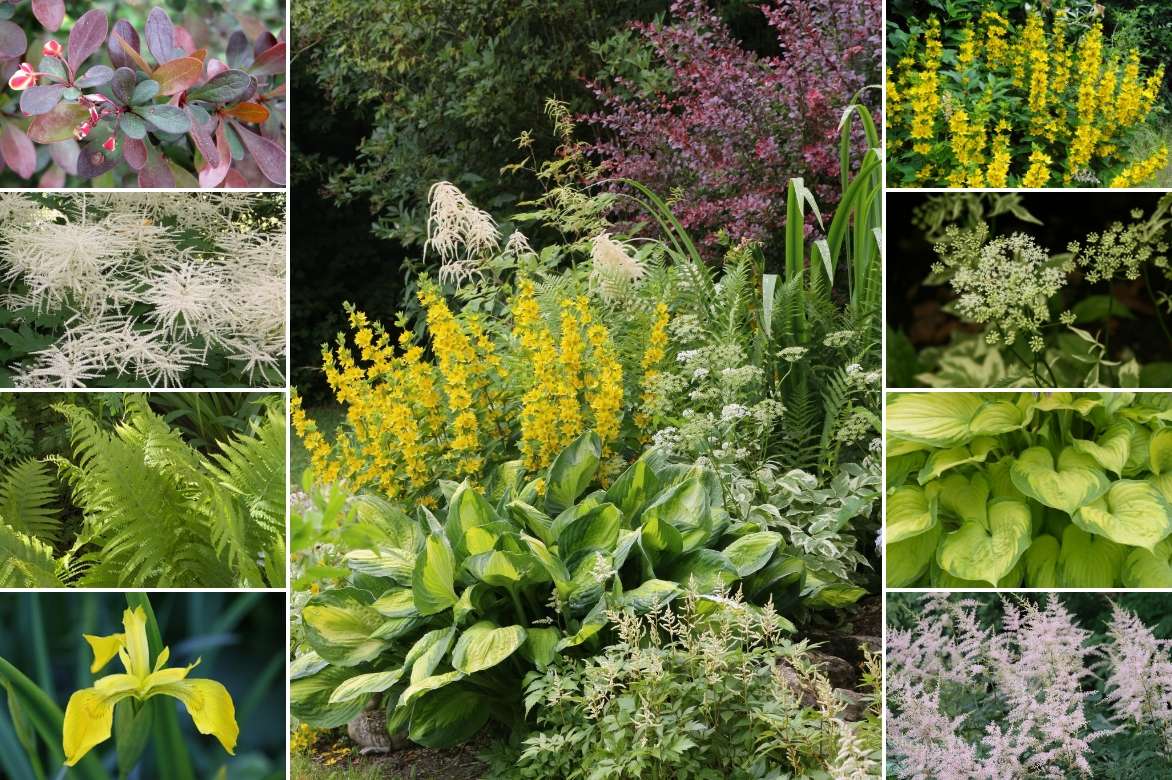
An example of a mid-shade association: Berberis thunbergii, Aruncus dioïcus ‘Sylvestris’, Dryopteris filix-mas, Iris pseudacorus, Lysimachia punctata, Aegopodium podagraria ‘Variegata’, Hosta ‘Old Glory’, Astilbe simplicifolia ‘Hennie Graafland’
Berberis can also associate well with flowering shrubs such as Forsythia intermedia Spectabilis, abelias, Deutzia, Escallonia…
Remarkable subjects for their habit like Berberis Green Carpet and Tiny Gold can create a colourful checkerboard in a rockery, on a bank, or in a pot garden alongside Nandina ‘Fire Power’ with its purplish tones, silver-leaved artemisias, and Juniperus x media ‘Blaauw’ with bluish-green highlights, etc. They can also be installed in a compact shrub border composed of Abelia Kaleidoscope or Petite Garden, supporting the flowering of landscape roses.
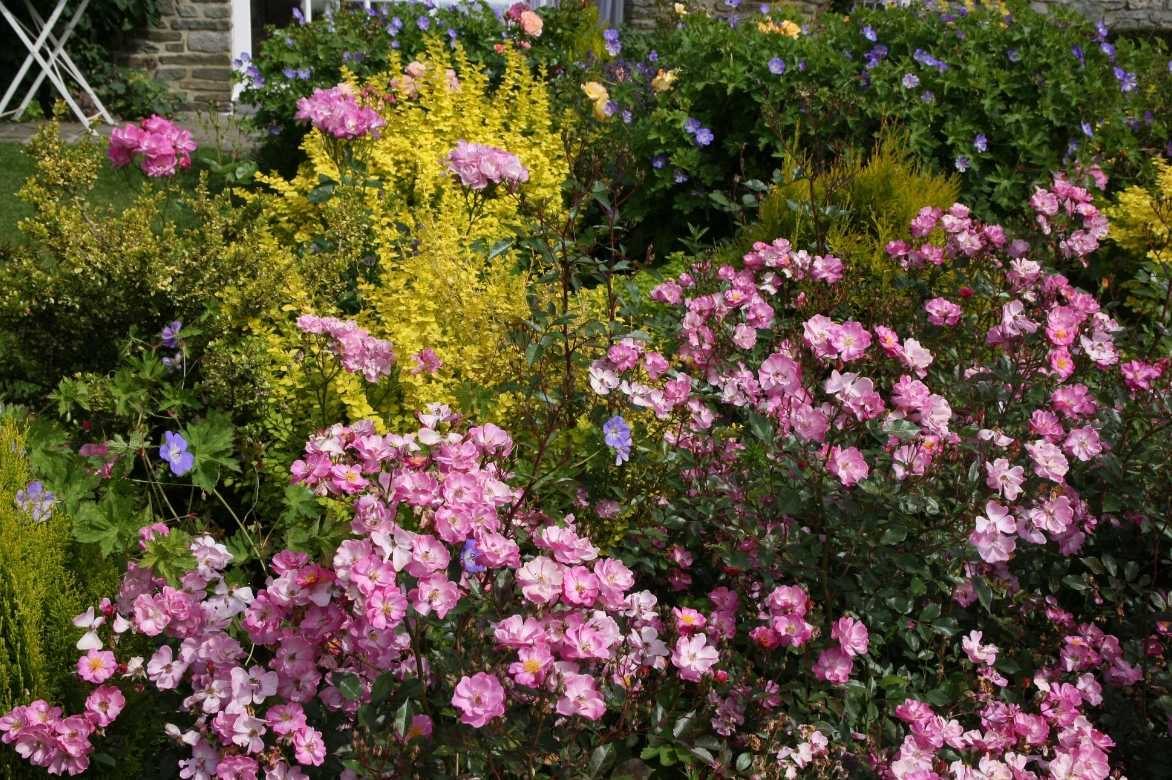
An example of a sparkling association: Rose ‘Lavender Dream’, Geranium ‘Rozanne’, Berberis thunbergii ‘Aurea Nana’
The small Berberis thunbergii Atropurpurea Nana or Bagatelle allow for punctuating borders with cute purple balls of 30 cm in diameter.
Evergreen Berberis darwinii can perfectly replace Pyracantha in a medium-sized defensive hedge, which should not be overly pruned: its naturally dense and tidy habit does not require it. While its berries are less spectacular than those of Pyracantha, it offers the advantage of maintaining modest dimensions and flowering twice, while providing more elegant foliage. But it also deserves to be paired with variegated foliage or placed in the foreground in front of a large rainbow screen made up of Ceanothus Puget Blue, pink, mauve, or white Abelias, red-flowering Japanese quinces, Kerria japonica, Genista Lena, or climbing honeysuckle Dropmore Scarlett with yellow-orange tones. Some, with great originality, even train it into a small tree with a single trunk by clearing a trunk and regularly pruning the branches.
Small compact shrubs from 1 to 1.20 m like Berberis thunbergii Admiration or ‘Orange Rocket’ can form a low hedge, alongside shrubs with golden or silver foliage. They can also highlight a border of perennials such as herbaceous peonies flowering in May-June.
→ Learn more about associations with Berberis.
For further reading
Discover:
- Our wide range of Berberis.
- Discover our tips on how to create a Berberis hedge.
- Our video The Berberis.
- Our video The Berberis julianae.
- Ingrid’s advice sheets on associating Berberis, growing a Berberis in a pot, and when and how to prune Berberis?
- Our advice sheets: Choosing a Berberis, 5 perfect Berberis for hedges, and Decorative flowering Berberis: our tips for choosing and planting this colourful bush.
- Our advice sheets: Evergreen Berberis, the most beautiful varieties, Purple Berberis, the most beautiful varieties; Berberis: 5 easy and colourful varieties to grow in pots; Variegated-leaved Berberis; The best dwarf Berberis for small spaces; 6 green-leaved Berberis.
- Our tutorial: How to propagate Berberis by cuttings?
- Subscribe!
- Contents
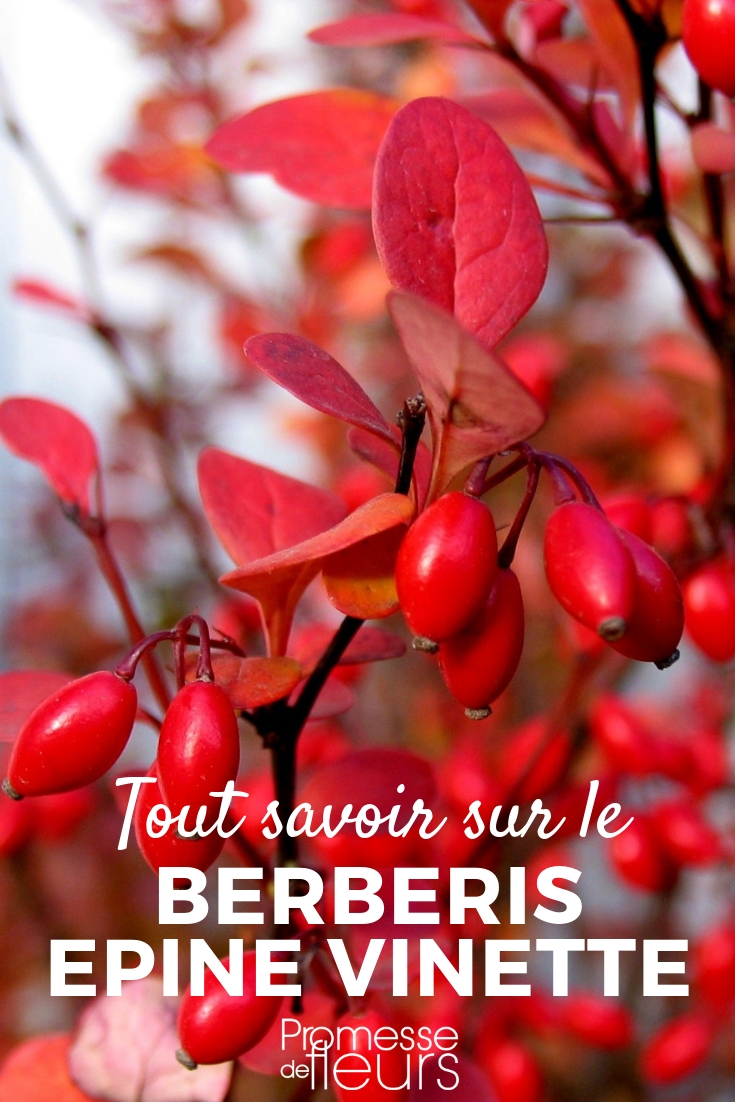































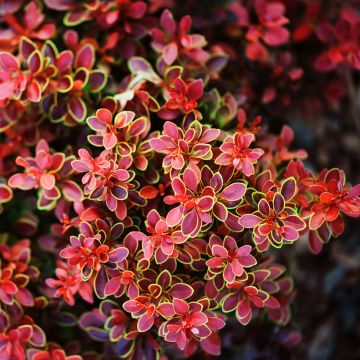
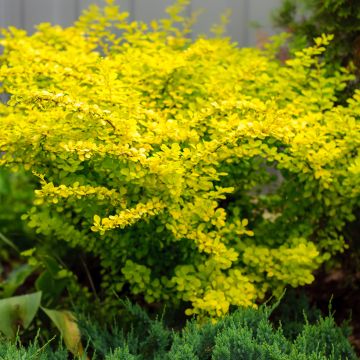
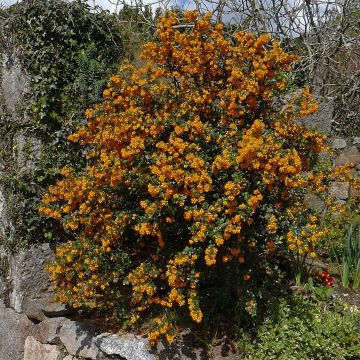

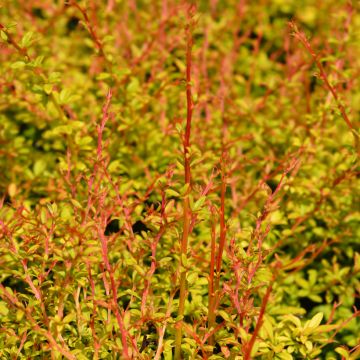
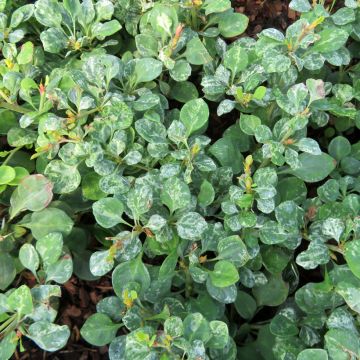

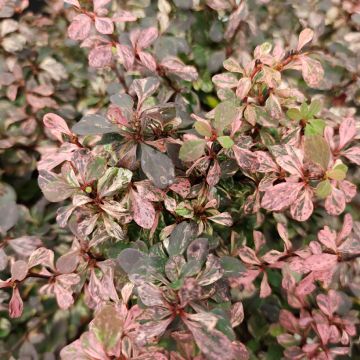
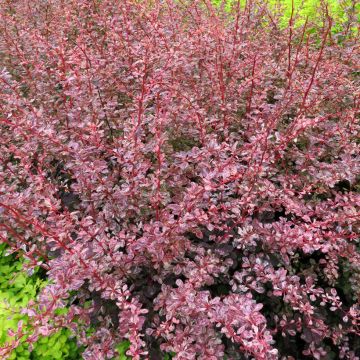
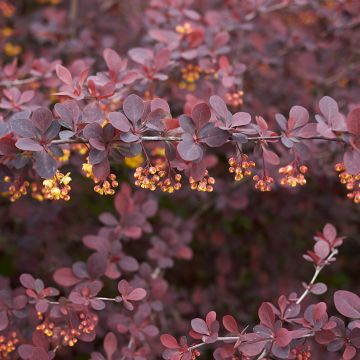
Comments